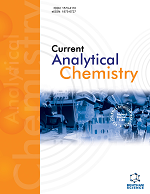
Full text loading...
We use cookies to track usage and preferences.I Understand

The cyclodextrin-based metal-organic complex (CD-MONT-2) exhibits Pb (II)-rings-based luminescence and water-stable properties. In this paper, it was successfully utilized as a multifunctional material, applied as a fluorescent probe for Ag+ and an adsorbent for Congo red.
X-ray powder diffraction analysis (PXRD), fluorescence analysis (FL), UV-Vis spectroscopy (UV-Vis), Fourier infrared spectrum (FTIR), X-ray photoelectron spectroscopy (XPS), scanning electron microscope (SEM) and SEM X-ray energy dispersive spectrum (SEM-EDS) were employed to study and prove the mechanism Ag2O-involved.
The fluorescence intensity clearly decreases as Ag+ solution (1 mM in H2O) is added continuously. At a dose of 1.67 mM, the maximum fluorescence “turn-off” condition is reached, and at 432 nm, the fluorescence quenching percentage is almost 65%. The adsorption capacity ofCD-MONT-2for Congo Red is 22.95 mg/g, with a removal rate of 71.98%. Methyl orange follows with an adsorption capacity of 7.46 mg/g and a removal rate of 22.83%. The adsorption ability of rhodamine B by CD-MONT-2 is poor, the adsorption amount is 6.76 mg/g, and the removal rate is 19.75%.
The multifunctional CD-MONT-2 is utilized as an Ag+ probe through fluorescence quenching and naked-eye detection with good sensitivity and selectivity. The max fluorescence quenching percentage is 65% with the Ag+ concentration of 1.67 mM, and the LOD is calculated to be 0.3856 mM. As an adsorbent, we found that the Congo red (anionic dyes) could be efficiently adsorbed. The adsorption performance may come from the mutual attraction of positive and negative charges, and the interaction between CD-MONT-2-OH and Congo red-NH2. The kinetic results indicate that the adsorption process of CD-MONT-2 on CR is more in line with the pseudo second-order kinetic fitting model and is influenced by chemical reactions.

Article metrics loading...

Full text loading...
References


Data & Media loading...
Supplements